The unusual physicochemical properties of azulene and azulene-based compounds
2019-12-18LiangOuYunyunZhouBinWuLiangliangZhu
Liang Ou,Yunyun Zhou,Bin Wu,Liangliang Zhu*
State Key Laboratory of Molecular Engineering of Polymers,Department of Macromolecular Science,Fudan University,Shanghai 200438,China
Keywords:
Azulene
ABSTRACT
Azulene,an isomer of naphthalene,has become one of hot chemical structures in the research field of functional materials,due to its anti-Kasha’s rule emissions and unusual physicochemical properties(e.g.,photophysical,electrochemical,and photoelectrochemical properties).In the past,the synthesis of azulene-based compounds is relatively inconvenient.Recently,there have been more and more reports about the synthesis strategies of the azulene-based compounds for finely tuning the physicochemical properties.In this article,we introduce several synthetic methods for kinds of azulene-based compounds which has unusual physicochemical properties.With these convenient methods and unique physicochemical properties,azulene-based compounds can be applied into many fields such as specific bioimaging,advanced molecular switches,organic field-effect transistor (OFET),organic light emitting diode (OLED),solar cells,and so forth.And these properties are also summarized here.
1.Introduction
In 1863,Piesse obtained a blue organic matter from oil of wormwood and named it as“azulene”[1].Due to its unusual structure,azulene had attracted wide interests of many research groups over the years.In 1939,Pfau finished its chemical synthesis,undoubtedly accelerating the development of the azulene family [2].Azulene has a 10-π electron system,and the resonance delocalization of azulene affords cyclopentadienyl anionic and tropylium cationic character to gain the Hückel aromatic stabilization(Fig.1)[3].Due to this special structure,azulene has a large dipole moment of about 1.08 D and an unusual apparent color(deep blue)[4].On the contrary,the naphthalene only consists of two fused six membered rings,ensuring that it is colorless and has zero dipole moment [5].
Furthermore,as compared to its isomer naphthalene,azulene has a distinct absorption and electronic transition (Fig.2a).The non-mirror-related highest occupied molecular orbital (HOMO) -lowest unoccupied molecular orbital(LUMO)geometry of azulene results in a small energy gap between the ground state(S0)and the first excited state (S1).Therefore,the absorption from S0→S1transition is in the visible range,making azulene become the smallest isolable organic compound [6,7].With simple substitutions,the absorption of azulene can be varied remarkably[8].And the change of absorptions depends on both the kind of substitution and the position of substitution.
On the other hand,the emission of azulene is normally from S2,whereas the emission from S1is negligible,disobeying the Kasha’s rule [6].In 1950,Michael Kasha claimed that no matter what the excitation energy is,the emitting level of a given multiplicity is always the lowest level of that multiplicity for the vast majority of organic emitters,which is named as Kasha’s rule [9].In recent years,however,there are some reports about exceptional photophysical properties in azulene,thiones,pyrene,etc.,with anti-Kasha’s rule emission [10-12].
Since the intensity and wavelength of the absorption and emission of azulene is sensitive to a series of factors as compared to most π-skeletons,azulene-based material has been applied into many fields like molecular switches,liquid crystalline,nonlinear optics(NLO)materials,near-infrared(NIR)materials,organic fieldeffect transistor(OFET),organic light emitting diode(OLED),solar cells,and metal-organic framework(MOF)[13-21].However,due to its special chemical structure,azulene-based compounds is difficult to synthesize,especially the 2,6-substituted azulene[22].To facilitate the development of synthesis method of the azulene family,thus far,some groups has reported some new synthesis strategies about azulene-based compounds,including all derivatives with different substituted places.

Fig.1.azulene and its polarized resonance structure.
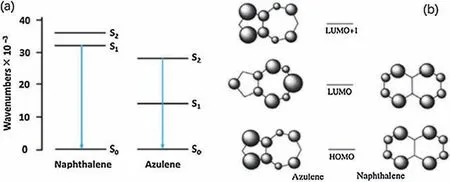
Fig.2.(a) Unique fluorescence observed for naphthalene and azulene.(b)Probability of locating an electron in the HOMO,LUMO,and LUMO+1 of azulene(left) and naphthalene (right).Spheres represent the squares of atomic orbital coefficients.Reproduced with permission[6].Copyright 2017,John Wiley and Sons.
2.Synthesis strategy of azulene-based compounds
Due to the electronic and structural properties of azulene,the synthesis of 2-and 6-substituted derivatives is especially difficult.Hence the past researches regarding the synthesis of azulenebased compounds almost focused on the synthesis of 1/3-substituted derivatives or 4/7-substituted derivatives [22].As compared to other derivatives,however,the 2- and 6-substituted derivatives of azulene have larger dipole moment because of the C2vsymmetry.Thus the 2- and 6-substitution can cause stronger π-conjunction,which is useful in the field of organic (opto)electronic devices [23].As shown in Fig.2b,the electron distribution in frontier MOs should be considered while functionalizing azulene[6].Due to the resonance delocalization,the 1-,3-,5-and 7-positions of azulene are electron-rich and can be reacted with electrophilic reactants.On the contrary,the 2-,4-,6- and 8-positions of azulene are electron-poor and can be reacted with nucleophilic reactants (Fig.3).
The 1- and 3-positions of azulene are the most active sites,so there are many reports about the synthesis of 1-and 3-substituted azulene derivatives.Some compounds of 1- and 3-substituted azulene derivatives are easily synthesized,just directly reacting with the electrophilic reagents in one step.For example,by the reaction with a fluorinating agents(Fig.3),1-fluoro-azulene can be prepared in one step with a high product yield about 34%.The 1,3-fluoro-azulene can also be prepared in this step with a product yield about 3% [24].
The π-extension of the compounds can be expected by using Suzuki-Miyaura or Stille coupling reactions to form biaryl compounds [25,26].And azulenesulfonium salts can also be prepared from corresponding structures [27].For 1-substituted azulene derivatives,metal-catalyzed conditions can be used for the regioselective activation of CH bond at the electron-rich 1-position.With the metal like gold or palladium as catalyst,some 1- substituted azulene can be prepared(Scheme 1)[28].
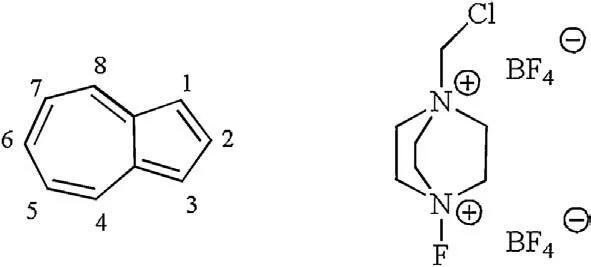
Fig.3.The numbering legend of azulene (left) and the fluorinating agents (right)[24].

Scheme 1.Reported metal-catalyzed methods for azulene CH bond functionalization and C--C bond formation.Copied with permission [28].Copyright 2018.ACS Publications.
Although other positions are less active,there are also some strategies to prepare these required structures.As compared to the 1-and 3-position,5-and 7-positions are less reactive so that the 1-and 3-positions should be basically protected first [29].The Stille cross-coupling can also occur on 6-position,with 1- and 3- positions already having substituent groups[26].Some peroxides can react with azulene to form 6-hydroxyl-azulene,which can be further modified [30].Competing with the addition at the 6-position,nucleophilic addition can react in 4-or 8-position in prior,and it can be easily added with methyl and phenyllithiums [6].
Although 2-position has low coefficients relatively,there are still two popular strategies to prepare it.In the first strategy,azulene can react with some compounds such as pin2B2(Scheme 2,a)under the iridium catalysis,to form 2-substituted azulene[31].The other one for preparing 2-substituted azulene is shown in Scheme 2,route b [22].Without any catalysis,2-amino-azulene can easily react with Br2to prepare 2,6-substituted azulene.Further reactions can lead to much useful 2,6-substituted azulene,which can be applied into organic solar cells(OSCs),organic fieldeffect transistors (OFETs),and more [32].
In addition to the synthesis on 1,3-and 2,6-positions,Hawker and co-workers reported a strategy to prepare 4,7-substituted azulene with a high product filed in 2011( Scheme 3)[33].And few years later,their group found that 1,3-substituted azulene,2,6-substituted azulene,5,7-substituted azulene can also be prepared by the similar strategy [34].
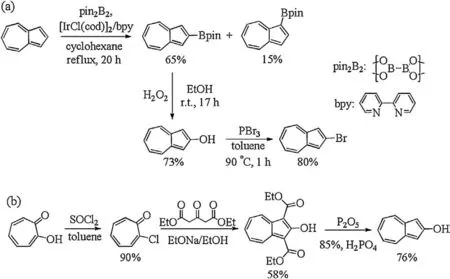
Scheme 2.(a) Synthesis of 2-bromoazulene.(b) Another synthetic route to yield azulene derivatives substituted at 2-position.
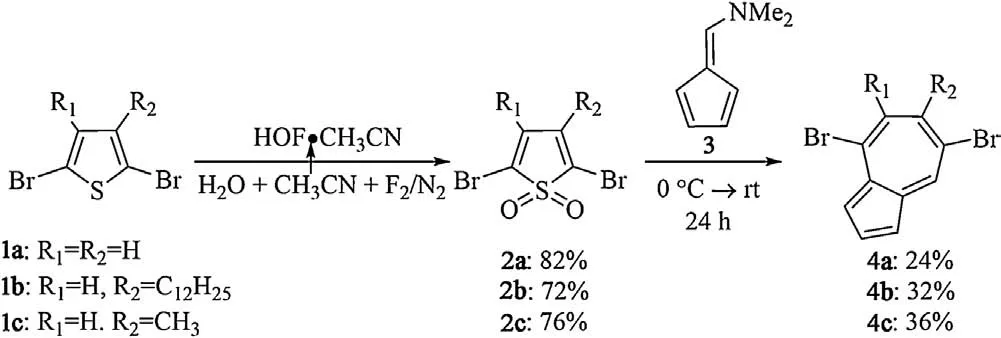
Scheme 3.Synthesis of 4,7-substituted azulene.
3.The unusual photophysical properties of azulene-based compounds
3.1.Application of emission of anti-Kasha’s rule
Due to the special emission of S2to S0,as well as the remarkable change of absorption with substitution,the azulene derivatives have been widely applied into some fields like nonlinear optics(NLO) materials,near-infrared (NIR) materials,and fluorescence probes.
In 2003,Robert and co- workers synthesized a series of substituted azulene ( Fig.4) to study the changes in the band gap,level structure and spectral properties with different substitution or in different substituted space[35].Compared with its isomer naphthalene,the LUMO+1 and HOMO of azulene is similar but the LUMO of azulene is substantially different.From LUMO to HOMO,the electron distributions of naphthalene are unchanged but electron distributions of azulene are totally different.The large difference means that it is possible to reduce the energy levels of these MOs and change the excited state,by attaching electron-donating or electron-withdrawing substituents to different ring positions.Attaching electron-donating at 1,3,5,7 positions will raise the energy level without changing the LUMO.Meanwhile,this effect will decrease the S0-S1energy gap and increase the S1-S2energy gap.The electron-withdrawing will lead to an opposite effect.The changes in the band gap and level structure lead to the change in apparent color.The azulene with electron-withdrawing substitution at 1,3 positions have a largely red-shifted absorption band,and even the maximum absorption peak of compound 10 (Fig.4) is up to 750 nm,indicating a good near-infrared material.
The anti-Kasha’s rule of azulene is even not limited in the S2to S0transition.In 2018,our group reported that azulene with three aldehyde groups (Fig.5a) has the emission from S3to S0initially[36].With the addition of water to establish the H-bonding effect,the emission of compound TA(Fig.5a)is regulated to be from S2to S0with a totally different luminescence color (Fig.5b).Through such a H-bonding,the emission was controlled for realizing a superior emissive switching between S2to S0pathway and S3to S0pathway.

Fig.4.A series of substituted azulene synthesized by Robert’s group.
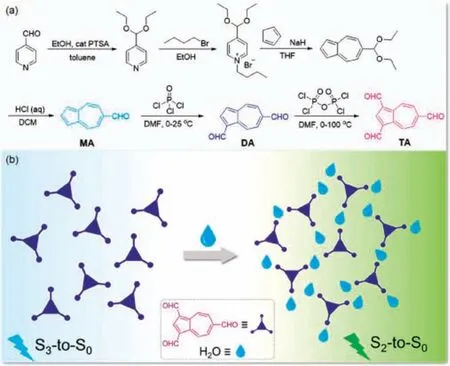
Fig.5.(a)Synthetic route for the preparation of compounds MA,DA and TA.(b)A proposed process for the formation of intermolecular H-bonding of compound TA upon addition of a small amount of H2O,accompanied by an anti-Kasha’s rule luminescent conversion.Copied with permission [36].Copyright 2018,ACS Publications.
In 1988,Morley reported that azulene derivatives may have NLO properties as electron donator by computational investigation[37].Owing to the unusual electronic structure,azulene has large nonlinear optical responses,leading to potential application in nonlinear optics [14].In 1998,Herrmann reported that azulene combined with ferrocene could be an electronic accepter [38].In 2000,Lacroixet al.reported that 1-(4-nitrophenylazo)azulene possesses a β value of 80×10-30cm5/esu(at 1.907 μm),larger than that of 2-[N-ethyl-4-(4-nitrophenylazo)phenyl-amino]ethanol)(DR1),a related and well-known stilbene-based chromophore[39].In 2004,Lacroix reported on a series of cationic dyes built up from various 1-methylpyridinium based substituents as electron acceptors to investigate the potential application of azulene in nonlinear optics.And they also found that the substituted azulene may be used in cubic nonlinear optics [14].
3.2.Application of emission of Kasha’s rule
Recently,our group reported that azulene derivatives may overcome the limitation of the anti-Kasha’s rule emission,to realize a unique NIR emission.We found that the substitution of cyanostyryl can make azulene result in a controllable dual-channel imaging effect with the unimolecularly tunable visible-near Infrared luminescence [40].Compound A1was designed for the fundamental photochemical and photophysical studies in organic solution,while compound A2was for cell imaging application(Fig.6a).The strong emissions of A1and A2were only discovered when they are inE-form,so that the dual-channel (NIR and Vis)imaging can be realized by designing the structure of the compounds(Fig.6c).Fortunately,theZ/E-isomerization can occur easilyviapH and light control(Fig.6b),featuring such a material is smartly tunable.Furthermore,these compounds have so little biotoxicity that they can be used wellin vivo.The observation of the Kasha’s rule emission in this system can be attributed to 1) the enhancement of the S0to S1transition that increases the probability of the radiative decay from the S1state (referenced from the UV-vis spectral change),2)the conformational restriction of theE-form that can be helpful for inhibiting the nonradiative relaxation processes.
4.The unusual electrical properties of azulene-based compounds
Conjugated polymers have exhibited their huge potential as active materials in organic (opto)electronic devices such as organic solar cells (OSCs) and field-effect transistors (OFETs)[23].Correspondingly,azulene has also been employed into these materials for exerting specific optoelectronic behaviors tuning.
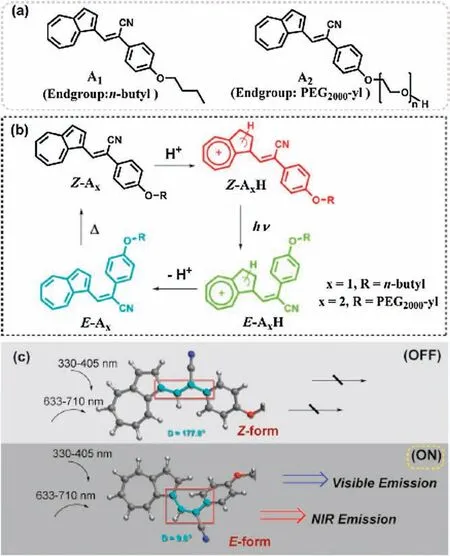
Fig.6.(a)Chemical structures of the cyanostyryl-modified azulenyl compounds A1 and A2; (b) The protonation-assisted photoisomerization process; (c) Optimized conformational (up) Z- and (down) E-forms of the cyanostyryl-modified azulenyl moiety at the B3LYP/6-31G*level of theory and the illustration of the tunable dualpathway emission behaviors: the Vis and NIR emissions are both quenched in Zform in contrast to the E-form.Copied with permission [40].Copyright 2017,John Wiley and Sons.
4.1.Application in organic solar cells (OSCs)
In 2004,Piotrowiak reported that azulene and its derivatives with some substitutions can absorb light and transfer the photoinduced electrons to TiO2,showing the possibility for azulene application in organic solar cell materials (Fig.7) [41].In 2006,Zhang and co- workers reported that four azulene-based dye molecules,3-(azulene-1-yl)-2-cyanoacrylic acid,3-(7-isopropyl-1,4-dimethylazulen-3-yl)-2-cyanoacrylic acid,5-(azulen-1-yl)-2-cyanopenta-2,4-dienoic acid,and 5-(7-isopropyl-1,4-dimethylazulen-3-yl)-2-cyanopenta-2,4-dienoicacid have unusual photoelectrochemical properties that has great potential application in organic solar cells[42].Thereinto,the photoelectric conversion efficiency of 5-(7-isopropyl-1,4-dimethylazulen-3-yl)-2-cyanopenta-2,4-dienoicacid is 2.9%,which is the highest in such a series of compounds.
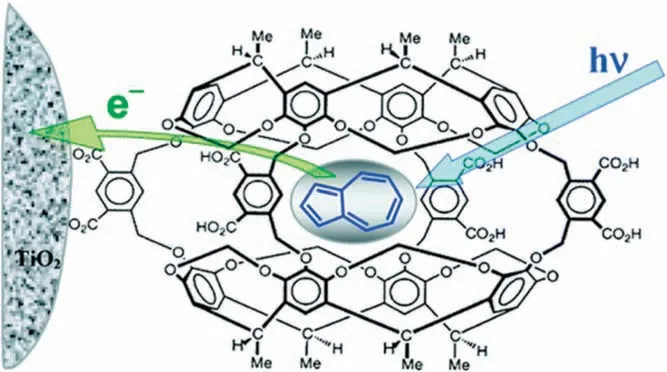
Fig.7.Azulene can absorb light and transfer the photo-induced electrons to TiO2.Copied with permission [41].Copyright 2004,ACS Publications.
Azulene can also be the electron donor in electron donor(D)-acceptor(A)polymers for constructing organic solar cells.In 2015,Zhang and co- workers reported that they synthesized three conjugated polymers with dithienyldiketopyrrolopyrrole (DPP)and azulene.They can also be applied for solar cells with the highest photoelectric conversion efficiency up to 2.04% [43].In 2015,Murataet al.reported that tetra-substituted azulene can be used as a hole-transporting material (HTM) in perovskite solar cells.They observed that the power conversion efficiency is 16.5%,beyond the current HTM standard material Spiro-OMeTAD [18].
4.2.Application in organic field-effect transistor (OFETs)
As an important classes of electronic devices,organic fieldeffect transistors(OFETs)have numerous important applications in many fields [44].In 2007,Leeuw and co- workers reported that azulene-based compound has potential to be used in OFETs [6].After that,there have been more and more reports about the application of azulene in organic field-effect transistors.For example,in 2012,Katagiri reported that they synthesized 550-di(2-azulenyl)-220-bithiophene and 2,5-di(2-azulenyl)-thieno[3,2-b]thiophene,with the hole mobilities up to 5.0×10-2cm2V-1s-1[45].In 2016,Katagiri and co- worker reported that 2,6′:2′,6′′-terazulene,6,2′:6′,6′′-terazulene exhibited excellent performance as an n-type organic field-effect transistor,while 2,2′:6′,2′′-terazulene,2,2′:6′,6′′-terazulene acted as both n-type and p-type organic field-effect transistor ( Fig.8) [17].The FET mobilities were gradually improved with increasing temperature.At 100°C,the electron carrier mobilities of TAz3 can even be as high as 0.31 cm2V-1s-1,and the hole mobilities of TAz2 can be as high as 1.32 cm2V-1s-1.
In addition,Prof.Gaoet al.developed biazulene diimides as another type of new azulene-based candidate for constructing optoelectronic materials in 2016 [46].Relative to other pertinent skeletons,their materials have relatively higher LUMO energies as well as narrower band gaps.When biazulene diimides were polymerized,they found these polymers can exhibit unipolar ntype transistor performance with relatively high electron mobility[32].These results show that developing new azulene-based building block like biazulene diimides is one of effective strategies for advancing organic electronic materials and devices.
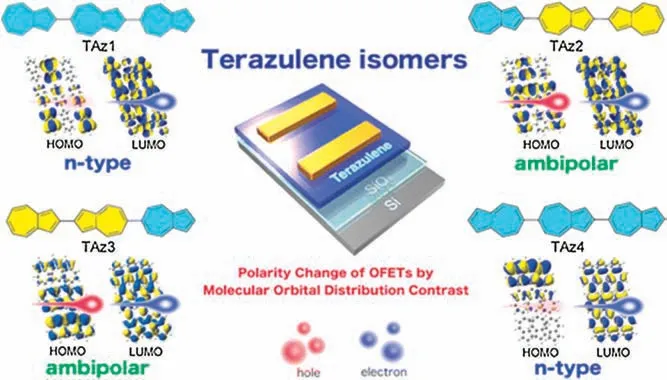
Fig.8.Polarity change of OFETs by molecular orbital distribution contrast.Copied with permission [17].Copyright 2016,ACS Publications.
5.Conclusion
As mentioned above,azulene has abundant physicochemical properties including photophysical properties and electrochemical properties,on account of its special structure and electronic structure.Therefore,it has been well applied into many fields like nonlinear optics (NLO) materials,near-infrared (NIR) materials,organic solar cells (OSCs),organic light emitting diodes (OLEDs)and organic field-effect transistors (OEFTs).In the past,the application of azulene and its derivatives has been limited because of the difficulties of synthesizing the azulene substituted derivatives of some position.These years,with more and more reports about new synthesis strategies,the synthesis of some certain substituted azulene has been possible and convenient.With the development of new synthesis strategies for different substituted position and substituendum,the more and more substituendums that can largely influence the properties of azulene can be attached to the azulene.Thus,better azulenebased materialsmay be formed in future.On the other hand,the azulene and its derivatives can be conjuncted with many superior organic function materials or devices to form advanced hybrid function materials,which has exhibited better properties than the precursor materials in absorption,energy transfer,stimuliresponsivity and more.These hybrid materials formed can be applied in other fields.In this way,we can foresee that the azulenebased materials can perform much more widely sooner or later.
Acknowledgments
This work was supported by the National Natural Science Foundation of China (No.21644005) and National Program for Thousand Young Talents of China.
杂志排行
Chinese Chemical Letters的其它文章
- Recent advances in organic pressure-responsive luminescent materials
- Novel expanded porphyrinoids with multiple-inner-ring-fusion and/or tunable aromaticity
- Recent advances in photofunctional polymorphs of molecular materials
- Chiral self-assembly regulated photon upconversion based on triplet-triplet annihilation
- Luminescent Cu(I) and Ag(I) coordination polymers: Fast phosphorescence or thermally activated delayed fluorescence
- Macrocyclic versus acyclic preorganization in organoplatinum(II)-based host-guest complexes
